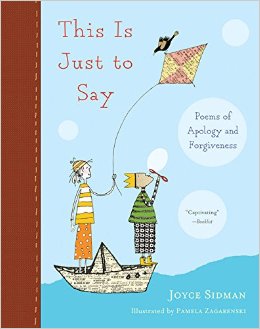 April is National Poetry Month, which is as good an excuse as any to take some poetry books off the shelf and have a read. I’m quite methodical in April — it’s the hint of spring in the air, I suppose. I clean my office and then I build a stack of wonderful poetry books — some Billy Collins, a little Emily Dickinson, a tome of Robert Frost, Shakespeare’s sonnets, Mary Oliver, naturally…..
April is National Poetry Month, which is as good an excuse as any to take some poetry books off the shelf and have a read. I’m quite methodical in April — it’s the hint of spring in the air, I suppose. I clean my office and then I build a stack of wonderful poetry books — some Billy Collins, a little Emily Dickinson, a tome of Robert Frost, Shakespeare’s sonnets, Mary Oliver, naturally…..
On top of this fine stack I put my collection of Joyce Sidman books. This means, to be honest, that I seldom make it down to the “grown-up” poets. Which is fine — I’m quite perfectly happy wandering in Joyce’s books for the entire month. The others can be read…whenever. Joyce’s books have pictures. In the words and on the pages. I think all poets should be illustrated.
I say “Joyce,” all familiar like, because I know her. Which seems too fantastic to be true — I know none of those other poets, except through their work. But Joyce I know — I saw her this past weekend, in fact. I hear her voice in her poems — even when it’s not her voice speaking. (I hear Billy Collins in his poems, too, but Joyce’s voice is not so deadpan.)
We’re several days into April and I’ve yet to make it past the book that is possibly my favorite in my Joyce Sidman collection: This is Just To Say: Poems of Apology and Forgiveness. It’s a slim volume — paperback. Sometimes it gets shoved back on my bookcase and I panic when I look up and don’t see it right away. It’s illustrated by Pamela Zagarenski, an artist whose website I sometimes visit just to browse and mutter her last name over and over again like its own poem. She has illustrated a few of Joyce’s books. They are an inspired pair, I think.
I bought this book as soon as I saw that the very first poem was, as I suspected, William Carlos William’s “This Is Just To Say,” one of my most favorite poems. Another of his poems “The Red Wheel Barrow” is one of the only poems I’ve managed to keep memorized since college. I recite it when walking sometimes still.
Joyce uses William’s poem, “This is Just To Say,” as a model when she teaches, so says her website. And it is the model for this brilliant book of poetry: a story — or perhaps I should say stories—told through poems of apology and forgiveness.
I’m embarrassed to say that I did not realize this book told stories until I read some of the poems aloud to a group of pre-schoolers. An astute 4‑year-old pointed out to me that one poem went with another, which is when I realized the poems were in pairs. (We’ll just focus on the brilliance of the 4‑year-old and not my sloppy reading.) Ever since, when I read this book, I read the apology poem and then the “follow-up poem,” which is often a forgiveness poem, but sometimes just an explanation — and therein lie the stories. And these stories — my heart! — they run the gamut of the lives of children. From dodge ball games to mean things said…from things breaking to breaking hearts…from secrets kept to confessions made….from crushes to honest-to-goodness love…from frightened kids to despairing parents.
It’s the best of poetry, truly. Accessible, meaningful, rich. I’ll just spend this April here, thank you very much.
